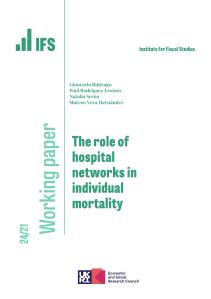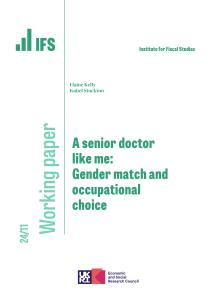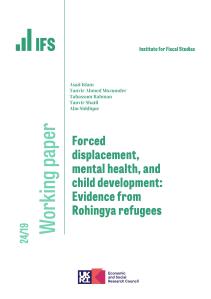The performance of the NHS will likely be frequently debated between now and the upcoming general election. And the measure most often used is the size of the waiting list. But most analysis of waiting lists, including our recent pre-election briefing, starts in 2007, for the simple reason that this is the period for which consistent data are available. In this comment, we extend this analysis further back and examine how the waiting list and waiting times in England have changed since 1987.
Changes in data definitions make long-run comparisons of the NHS waiting list challenging, and we should be sceptical of overly simple claims and narratives. For example, because of changes in measurement, it is not possible to say whether waiting lists post-2010 have been higher or lower than under previous governments.
But we can draw broad conclusions from the available data. The NHS waiting list in England rose under Conservative governments from 1987, but at the same time, the average (median) waiting time and the number waiting for more than a year fell. The waiting list then fell substantially under Labour governments from 1997, but average waiting times only started to fall again from the early 2000s. Waiting times were lower under Labour governments than under the previous Conservative governments. Since 2010, both the NHS waiting list and median waiting times have risen, but not by enough to return to the very long waits experienced in the 1980s and 1990s.
How has the NHS waiting list changed over time?
The elective waiting list is the number of incomplete pieces of elective (pre-planned) hospital activity. Since 1987, the NHS has used three different measures of the elective waiting list1 . The first measure was produced between June 1987 and February 2009. It counted the amount of incomplete inpatient and day-case elective activity, but did not include outpatient appointments (those that do not require hospital admission), another important part of elective care. As a result, a new measure was introduced in 2004 which also counted waits for first outpatient appointments after GP referrals. This expanded measure of the waiting list was produced between April 2004 and February 2009.
Under both measures, a patient would be classed as on the waiting list for inpatient or day-case activity if a hospital had decided to admit the patient. Throughout, we will refer to these two measures as decision to admit (DTA) measures. But a patient would often have to wait a long time for that decision to admit. This might involve, for example, waiting between an initial GP referral and an outpatient appointment with a hospital doctor (which may be included as part of the outpatient waiting list) and then waiting after that appointment for a decision (which would not be included). In other words, the waiting list measure only captured one portion of a patient’s overall waiting time, and lots of patients who were in fact waiting for hospital care would not be included on the waiting list.
As a result of this limitation, the current measure of waiting lists instead defines a patient as on the waiting list from the moment they were referred for treatment by their GP or by another health professional. This is called the referral to treatment (RTT) waiting list and has been produced since August 2007. Like the previous waiting list measures, it includes people waiting for inpatient, day-case and outpatient activity. Of course, this still excludes, for example, those who are waiting to see their GP and those who have seen their GP but are awaiting test results ahead of a referral.
Figure 1 shows each of these three waiting list measures over the periods they were produced. The changes in definition clearly make a large difference to the size of the waiting list. In February 2009, for example, there were 572,000 incomplete inpatient or day-case treatments with a decision to admit (the green line). There were an additional 865,000 incomplete outpatient treatments, so the DTA measure that included all types of activity (the yellow line) stood at 1.44 million incomplete treatments. But there were also 913,000 treatments without a decision to admit (i.e. the patients had been referred, but the hospital had not yet decided whether they needed admitting), meaning the current RTT measure (the blue line) stood at 2.35 million incomplete treatments.
The three measures are therefore based on very different definitions and cannot be directly compared2 . The old DTA measures are much lower than the current RTT measure, but this does not mean that the number of patients waiting for elective activity in the 1990s was necessarily lower than in the 2010s: they measure different things. If we included outpatient activity and we measured waiting from the initial referral rather than the decision to admit, it may be that the number of patients waiting for elective activity in the 1990s was higher – or lower – than in the 2010s.
We should also be careful about comparing growth rates in each of these measures. Between August 2007 and February 2009, the current RTT measure declined by an average of 3.2% per month. Over the same period, the old DTA waiting list measures declined by just 0.6% per month. This suggests that the number waiting for a decision to admit after a referral was changing at a different rate from the number with a decision to admit. So the two waiting list measures were not moving in parallel over this period, and therefore we cannot safely assume that different measures would have the same growth rates over other periods. This means that graphs that splice together these series (such as the one produced by the Financial Times and since used by the Labour party on multiple occasions) risk painting a misleading picture about the size of the waiting list over time. This is because the splicing assumes that different measures of the waiting list would have grown at the same rate, which they are not doing when the series overlap.
What we can confidently say is:
- between 1987 and 1998, the old DTA waiting list measure was growing, peaking in March 1998. It then fell fairly consistently until the measure stopped being produced in February 2009;
- including outpatient activity tells a similar story: between 2004 and 2009, this waiting list was also falling;
- from 2007, using the current RTT measure of waiting lists, the waiting list fell rapidly until 2009, before starting to rise steadily from 20123 .
How have NHS waiting times changed over time?
What really matters for patients is how long they must wait for care, rather than the overall size of the waiting list (though, of course, the two are related). For the reasons discussed in the previous section, it is also very hard to compare waiting times over time. In this section, we explore what we can say about waiting times over the past four decades.
For each of the waiting list measures, Figure 2 shows the median waiting time for those still on the waiting list (rather than those who have received treatment)4 . For the old DTA measure, the waiting times for inpatients and outpatients on the list were reported separately, unlike for the new RTT waiting list measure5 . The three sets of waiting times are therefore not directly comparable, both because they cover different sets of elective activity and because the DTA and RTT measures use different definitions of when waiting starts.
As with the size of the waiting list, we can compare the trends in each series. But we cannot safely compare the levels or growth rates across the series. The median waiting time for inpatient and day-case activity under the old DTA measure declined fairly consistently between 1987 and 1996. This is in contrast to the size of the waiting list, which was rising over this period. A higher waiting list and lower median waiting time might seem contradictory, but they are possible if, for example, there is a big increase in both the number of people needing treatment and the number receiving treatment because the NHS is carrying out more activity. At any one point, there may be more people waiting for treatment, but they are also being treated faster and so spending less time waiting.
The median waiting time only started falling consistently again from 2003 and it continued to do so until 2009. Median waiting times for outpatient appointments under the old DTA measure also declined consistently from 2004 to 2009. Because waiting times declined over this period, they were lower under the New Labour governments of 1997 to 2005 (and likely until 2010) than under the Conservative governments between 1989 and 1997.
In 2007, median waiting times under the current RTT measure were much higher than under the old DTA measure, as we would expect given the differences in definition. The median waiting time fell rapidly until 2009. It then remained relatively constant before starting to increase gradually from 2012. During the COVID-19 pandemic, the median waiting time increased rapidly. Although it has since fallen from its peak in 2020, the median waiting time remains much higher than pre-pandemic and is continuing to grow6 .
The median is just one measure of the distribution of waiting times and there have often been concerns about the longest waits. Figure 3 therefore shows the number of waits longer than a year7 .
The pattern of results is similar to that for the median waiting time. The number of waits over one year fell considerably from 1987 to 1996. It then rose from 1996, before falling from 2002 and reaching almost zero by 2003. Under the new RTT measure, there were many more patients waiting more than a year in 2007, as we might expect given the differences in definition. The number waiting more than a year then declined rapidly and reached almost zero by 20128 . Although the median waiting time rose during the 2010s, the number waiting more than a year remained almost constant and near zero before rising rapidly during the pandemic.
As with the median waiting time and the total size of the waiting list, we should be very cautious about comparing the different measures of patients waiting more than a year. But in this case, there is one comparison that we can make. The differences in definition mean that the RTT measure of a waiting time should always be longer than the old DTA measure, because the RTT measure also includes the time between a referral and a decision to admit. Since there were almost no waits longer than one year under the RTT measure in the 2010s, this also implies that there were almost no waits longer than one year if we had instead used the old DTA measure9 . This suggests that there were far fewer people waiting more than a year for treatment in the 2010s than in the late 1980s and 1990s.
Since the start of the pandemic, the number waiting more than a year under the RTT measure has increased considerably. We cannot meaningfully compare this with the number waiting more than a year in the 1980s and 1990s because the RTT measure is now higher than the old DTA measure. This could be because people are genuinely waiting longer for care than in the 1980s and 1990s, but it could also be driven by the differences in definition that mean that the RTT measure of waiting times is always longer than the old DTA measure.
Conclusion
It is natural to want to compare public service performance under different governments, particularly in an election year, but changes in definitions and measurement can make this challenging. In this comment, we have focused on the case of the NHS waiting list in England. The available data do not allow for easy comparisons over time, and we should be sceptical of overly simplistic analysis or narratives. Because of the changes in definitions, it is not possible, for example, to say whether NHS waiting lists are truly higher or lower under different governments before and after 2009.
But the available data do suggest some rather nuanced trends for NHS waiting lists and waiting times over the last four decades. Under Conservative governments between 1987 and 1997, the NHS waiting list rose substantially. But at the same time, the median waiting time – arguably more important for patients – fell, as did the number waiting more than a year. Under the Labour governments of 1997 to 2010, the waiting list fell substantially, but waiting times only started to fall from the early 2000s. Nonetheless, median waiting times for inpatient and day-case activity were lower under the New Labour governments than the preceding Conservative governments.
Under the coalition and Conservative governments of the 2010s, the NHS waiting list has risen, as have median waiting times. But waits of more than a year were nowhere near as common as they were in the 1980s and 1990s. Since the COVID-19 pandemic, however, both waiting lists and waiting times have increased dramatically. As for other governments over the last four decades, cutting NHS waiting lists and times will therefore be a key challenge for the next government.









